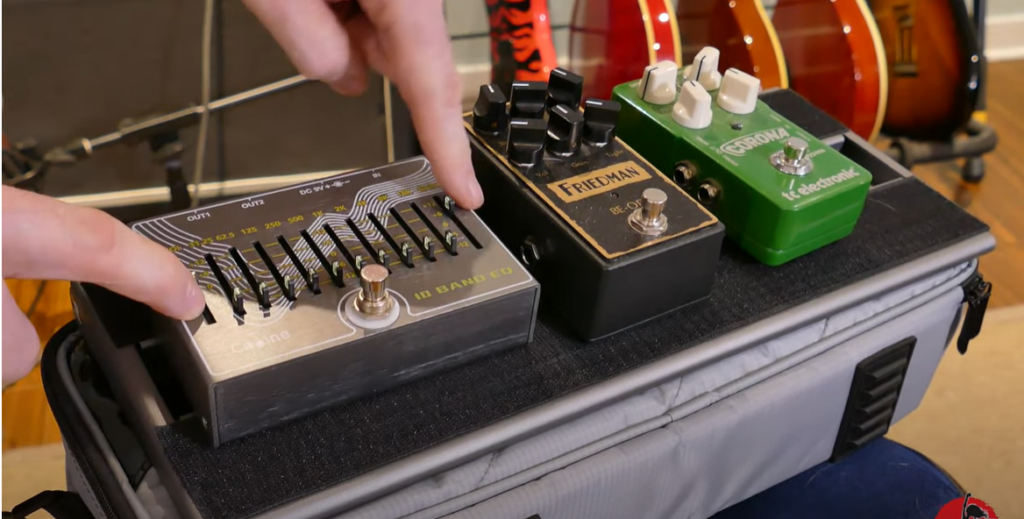A powered pedalboard is a piece of equipment that allows guitarists and bassists to keep their effects pedals powered and organized. It’s essentially a board that has a built-in power supply, allowing you to connect your pedals to a single source of power, rather than having to use multiple individual power supplies.
There are a number of advantages to using a powered pedalboard. For one, it simplifies your setup and saves space, as you don’t need to have multiple power supplies cluttering up your floor or pedalboard. It also ensures that your pedals are all receiving the correct voltage and current, which can help improve their performance and lifespan.
There are many different types of powered pedalboards available on the market, ranging from small and simple models to larger, more complex setups. Some are designed specifically for guitarists, while others are suitable for bassists or can be used by either.
One popular type of powered pedalboard is the Voodoo Lab Pedal Power series, which includes a range of different models to suit different needs. The Pedal Power 2 Plus, for example, has eight 9V outputs, two outputs for high-current effects pedals, and a range of voltage options for other types of pedals. It also includes a variety of different cables and adapters to ensure that you can connect all of your pedals.
Another popular brand is the Strymon Zuma R300, which is a smaller and more compact option. It has nine high-current outputs, as well as a USB port for charging your phone or tablet, and comes with a variety of different cables and adapters to suit different types of pedals.
Regardless of which brand or model you choose, there are a few things to consider when selecting a powered pedalboard. Here are some factors to keep in mind:
Power Requirements: Different effects pedals have different power requirements, so it’s important to choose a powered pedalboard that can supply the correct voltage and current for all of your pedals. Look for a model that has a range of voltage options, as well as high-current outputs for pedals that require more power.
Size and Portability: Powered pedalboards come in all shapes and sizes, so it’s important to choose a model that fits your needs. If you have a lot of pedals, you’ll need a larger board, but if you’re looking for something that’s easy to transport, a smaller model might be a better option.
Price: Powered pedalboards can range in price from around $100 to over $500, depending on the brand and model. While it can be tempting to go for the cheapest option, keep in mind that a higher-quality board will likely last longer and perform better.
Ease of Use: Look for a powered pedalboard that’s easy to set up and use, with clear instructions and intuitive controls. Some models even come with preset configurations for different types of pedals, which can save you time and hassle when setting up your board.
Durability: Finally, look for a powered pedalboard that’s built to last. You don’t want a flimsy board that will break after a few gigs, so choose a model that’s made from high-quality materials and has a solid build.
A powered pedalboard is a great investment for any guitarist or bassist who uses multiple effects pedals. It simplifies your setup, saves space, and ensures that your pedals are all receiving the correct voltage and current. When choosing a powered pedalboard, consider factors such as power requirements, size and portability, price, ease of use, and durability to find the best model for your needs. With the right powered pedalboard, you can take your guitar or bass playing to the next level.
In addition to the benefits outlined above, a powered pedalboard can also help reduce noise and interference in your signal chain. When using multiple pedals with individual power supplies, you may experience ground loops, hums, or other unwanted noise. By using a single, isolated power source, a powered pedalboard can help eliminate these issues and provide a cleaner, more consistent signal.
Another advantage of a powered pedalboard is that it can help you stay organized. With all of your pedals connected to a single board, you can easily see and access each pedal, and make adjustments or changes as needed. This can be especially helpful in live performance settings, where you may need to quickly switch between different effects.
When selecting a powered pedalboard, it’s also worth considering additional features that may be included. Some models, for example, have built-in tuner outputs or effects loops, allowing you to integrate other devices into your signal chain. Others may have adjustable voltage or current options, allowing you to fine-tune the power supply to suit specific pedals.
Of course, like any piece of gear, a powered pedalboard is not without its drawbacks. One potential disadvantage is that it can be expensive compared to individual power supplies. Depending on the brand and model, you may need to spend several hundred dollars to purchase a high-quality powered pedalboard. Additionally, some models may be heavier or bulkier than individual power supplies, which can make them less portable or harder to fit into smaller pedalboards.
Another potential drawback is that a powered pedalboard may not work with all types of pedals. Some boutique or vintage pedals, for example, may require specific power supplies or have unusual power requirements that cannot be met by a standard powered pedalboard. In these cases, you may need to continue using individual power supplies or look for alternative solutions.
Overall, however, the benefits of a powered pedalboard outweigh the potential drawbacks for most guitarists and bassists. With the right model, you can simplify your setup, reduce noise and interference, and keep your pedals organized and accessible. Whether you’re a seasoned professional or just starting out, a powered pedalboard can be a valuable addition to your gear collection.


